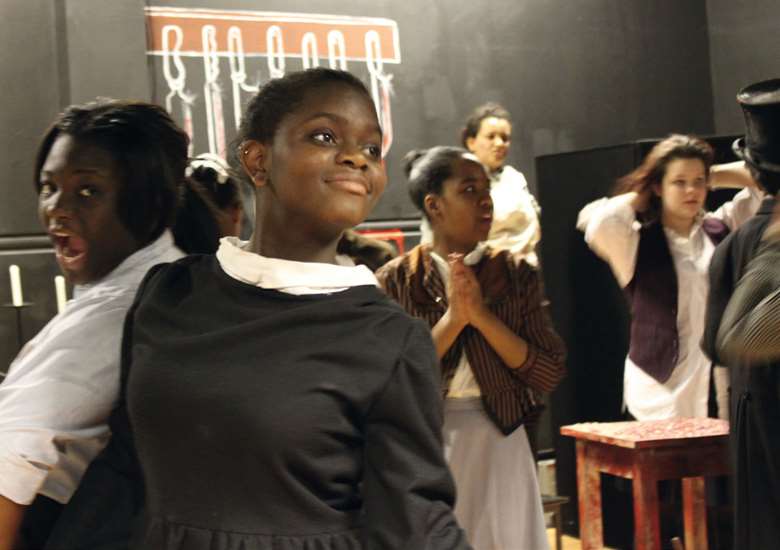Play for performance: The Gut Girls
Paul Willcocks
Tuesday, December 1, 2020
Each issue of D&T we bring you a page-to-stage focus on a play for performance with your students. This issue, Paul Willcocks, now Drama teacher at Ilford County High School for Boys, recounts how at his last school this gritty play by Sarah Daniels turned into his most ‘genuine’ school production yet

When I was a drama teacher at SSSO (St Saviour's and St Olave's Girl's School) and having directed countless musicals in its vast school hall, I found myself looking for a more intimate play to be performed in our smaller drama studio, which could highlight the ensemble nature of our students’ work.
I felt that, quite often, the girls were tending to associate school plays with all things ‘glitzy’ and I wanted to show that drama could be just as powerful without loud music, glittering costumes and a reliance on a couple of star performers. I wanted to present a play with a solid team of actors who were portraying, in an equal way, a believable group of rather gritty characters.
So, I chose The Gut Girls by Sarah Daniels.
A harsh reality
The Gut Girls traces the story of five young working-class women in the late 1800s who are toiling thirteen hours a day in the Cattle Market, where cows, pigs and sheep are slaughtered, cleaned and cut up. These ‘girls’ are working in one of the only industries where there was, for a time, plenty of employment for women – in some ways, they are more independent than most working-class women at the time. Yet they are still expected to obey the upper classes without question, which inevitably leads to horrific abuse.
This theme of independence versus subservience gave me, as director, motivation. Daniels’ play explores empowerment: the lack of it; the striving for it; the possible gaining of it. The story takes place a full decade before the Women's Social and Political Union became the Suffragettes, in 1903.
1903 was also the year when SSSO had been founded. Queen Elizabeth had visited St Saviour's when it had celebrated its centenary and the school often explored the changing role of women in powerful schemes of work. I wanted our production to reference some of these changes and celebrate the hard-won victories of the working woman.
Setting the scene
With this in mind, I searched for a song with which I could start the production. Dame Ethel Smyth wrote the March of the Women for the suffragists in 1911. Although anachronistic, as a ‘call to arms’ I thought it would be a perfect way to get the audience in the mood for the evening and prepare them for the essential struggles of the piece. What's more, the song would underline the ensemble nature of the piece, while providing the performers with an energetic vocal and physical warm-up each night.
As the cast explored the visceral work taking place in the gutting shed, it became apparent that we would have to take some bold decisions. Too often, school plays rely on sets and props to do the work, when really it's the actor who is the most powerful element. I wanted our audience to imagine what the workers were dealing with, through physical theatre and mime.
Extremely physical
All the gutting of the animals, the organs, the entrails, were suggested by extreme and often grotesque movement which would challenge the audience to fill in the visual gaps. As a plus, the students themselves would be developing their own physical skills and extending their knowledge of what performance is all about.
As we worked on the play, I noticed that, quite often, all the cast members turned up to rehearsal voluntarily. Many of the actors were in Year 10 and, if not in a scene, sat watching, intrigued by the ensemble process, making invaluable suggestions, getting on with their homework (or, with this particular cast, knitting) as they listened and watched the others at work. There can be a lovely family atmosphere in the rehearsal process. As long as you, as director, keep their real families up to speed with what's going on, this can be one of the most wonderful aspects of directing in a school.
Lasting legacy
There was so much that worked in our production of The Gut Girls, from the evocative piano linking the edited script together, to the sudden intimate moments of each haunting monologue, to the sheer comedy of the ‘girls’ training to be maids when the gutting sheds are closed down.
Most of all, the ensemble nature of the piece stays in the memory. When I moved on, the headmistress, Catherine May, made a speech in which she said that she had found The Gut Girls to be one of the more genuine plays I had directed. ‘Though you put on big school musicals such as Oliver! and The Wiz,’ she said, ‘I sensed that there was more of you in this play, more heart. And that translated to our girls. They gave of themselves.’ What more can you ask?
The Gut Girls is published by Samuel French and Methuen Drama

